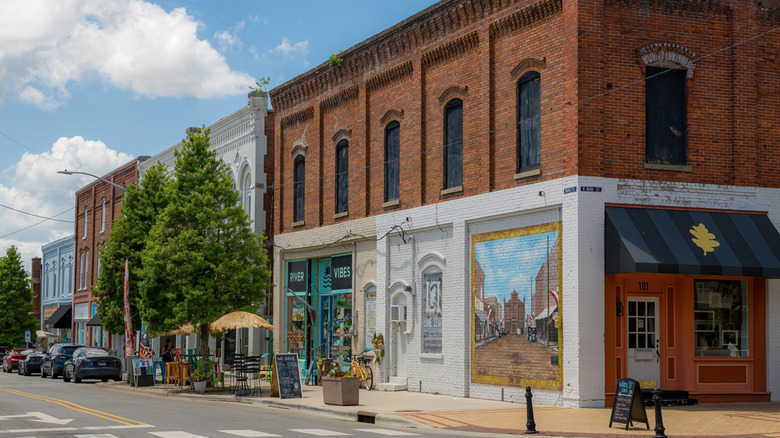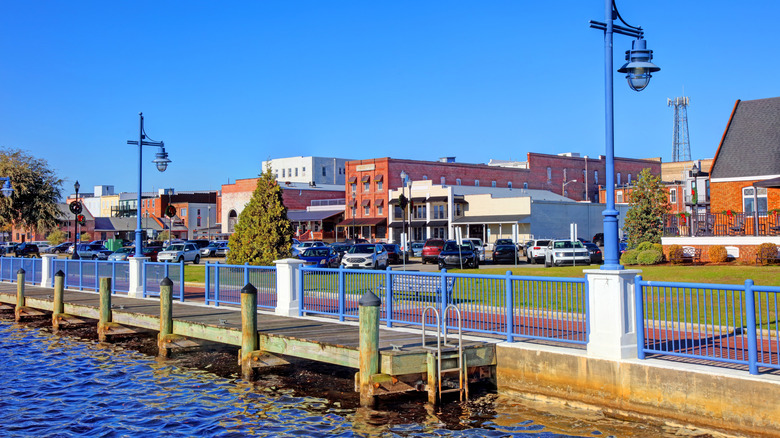North Carolina's 'Little Washington' Is A Charming Riverside City With A Scenic Boardwalk
Washington, North Carolina is a small city roughly 90 minutes from the state's central coast, situated at the head of the Pamlico River. Since its official founding in 1776, the area has earned the nicknames "Original Washington" (given that it was the original city with that name) and "Little Washington" (since it's smaller in size than Washington, D.C.). For such a small city, though — only 8.2 square miles — it packs a lot of punch.
Being a coastal destination, it exudes a certain sense of luxury with its waterfront mansions and yachts lining its marinas. But small-town charm is at its heart. Its modest size makes its riverfront area remarkably walkable, no doubt aided by the boardwalk where pedestrians can stroll along the Pamlico and take in views of boats and nearby islands. Just steps from the boardwalk are Washington's many bars, restaurants, shops, art galleries, and more. Less than a five-minute walk away from the boardwalk is the city's W. Main Street, where it's not uncommon to find gourmet wine shops, boutiques, fine dining establishments, and art galleries all on the same block. Whether searching for sunsets along the beautiful East Coast shoreline, quaint shops, or food and drink galore, look no further.
The nearest airport to Washington that offers commercial flights is the Pitt-Greenville Airport, roughly a 30-minute drive away, which typically has regional flights connecting through Charlotte Douglas International Airport. Greenville also has a regional transit hub, the G.K. Butterfield Transportation Center, approximately 30 minutes away, which provides access to Washington by bus. A bit further out — around 45 minutes of drive time — is the Coastal Carolina Regional Airport, which also services a limited number of regional commercial flights. The nearest international airport is Wilmington, which is a 2 ½ hour drive away.
A small city with big arts energy
Early on, the Little Washington region was home to Indigenous populations, including the Iroquoian-speaking Tuscarora. Despite some European settlers observing the Tuscarora's hospitality and generosity, many others colonized their native land and enslaved their people, leading to conflict that escalated into the Tuscarora Wars of the early 1700s. Eventually, the Tuscarora were defeated, and much of their land was lost, resulting in ongoing displacement. Today, the Tuscarora are one of the Six Nations of the Iroquois (Haudenosaunee) Confederacy, with a significant recognized presence in New York and Ontario, Canada. Although there are currently several recognized tribal communities in North Carolina, the Tuscarora are not among them, despite efforts.
Visitors to modern Washington have opportunities to learn about the area's Native American history, even if it is not directly within the city's limits. The Historical Museum & Indian Village of Grifton, located roughly 30 miles from Washington, features a Tuscarora room. But within Washington proper, travelers can experience the small-town charm alongside the city's history, all set against the idyllic waterfront view provided by the Pamlico River.
Along W. Main Street's less-than-1-mile stretch, there are at least four art galleries, as well as the Beaufort County Arts Council — a local nonprofit offering a range of arts programming throughout the year. The celebration of the arts in Washington goes beyond the four walls of galleries and theatres, making it a top-ranked East Coast city for art lovers to visit. Public murals have caught the attention of passersby and the media alike, such as the "Viva La Vida" mural created by professor and artist Georges Le Chevallier. Local press and PBS highlighted the artwork, which is a tribute to Washington's Latinx community.
Little Washington: When to go and how to get there
Like most of the U.S. South, summers in Little Washington tend to be hot and humid, with highs nearly reaching 90 degrees Fahrenheit in July, its hottest month. However, Washington is not without reason to visit in the summer. It's the season when the city hosts some of its most popular events, such as the annual Washington Summer Festival — a multi-day event packed with food, live music, and activities like a boat show, dance workshops, and a ticketed crab feast.
The mildest climate tends to occur in spring (April and May) and late fall (October), when temperatures typically hover in the mid-to-upper 70s. Be wary of hurricane season from June to the end of November. North Carolina is one of the most hurricane-prone U.S. states.
Within Washington's "downtown" riverfront, there are several lodging options that match the rest of the city's charm. The West Main hotel offers well-appointed yet modestly priced accommodations, featuring six unique suites starting at $155/night. Its on-site bar, 1906 Bistro & Bourbons, is a nod to the period of Washington's history (the early 1900s) when whiskies began making their way to the region. Within a few short blocks are two highly rated inn options: When Pigs Fly Inn, with rates starting at $125/night, and the Little Inn on Main, starting at $155/night.


